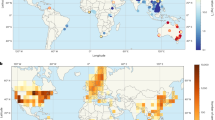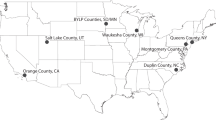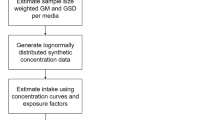Abstract
Background
Per- and polyfluoroalkyl substances (PFAS) are anthropogenic chemicals with unique properties and functionality that enable multiple industrial processes and product applications. PFAS are generally persistent, widely distributed in environmental media, and linked to various adverse health effects. The primary pathway of PFAS exposure to impacted communities is through contaminated drinking water. While many studies have demonstrated exposures from contaminated drinking water in such communities, less is known about the contribution of exposure from sources within the residential environment.
Objective
Measurement data on the nature and level of PFAS in house dust, indoor surfaces, indoor air, soil and wristbands are required to identify and understand important pathways for human exposure.
Methods
In this study, we collected house dust, surface wipe, indoor air, wristband, and soil samples at homes recruited from two communities previously impacted by drinking water contamination, one in Massachusetts and one in Delaware. At every home (n = 79), a floor dust sample was collected, while in a subset of homes (n = 28), more extensive environmental sampling was conducted. All samples collected were analyzed for up to 70 PFAS depending on the sample type.
Results
PFAS were found in all types of household samples, with 30 different PFAS detected in ≥50% of homes for at least one sample type. Vacuum dust, floor dust and soil had the highest detection rates across most PFAS. However, certain PFAS precursors were more prevalent in surface wipes, indoor air, and wristbands (e.g., FTOHs, FOSEs, FOSAs). diPAPs were widely detected across all sample types and had the highest concentrations among all analytes in dust, surface wipes and wristbands. A comparative analysis between the two sampling sites highlighted significant differences in PFAS profiles, with Delaware exhibiting higher levels of PFAAs in dust and soil, while Massachusetts showed greater concentrations of diPAPs across various media sampled.
Significance
These findings highlight the widespread presence of PFAS in the residential environment, and the need for mitigation strategies that address both legacy compounds and emerging precursors across numerous media.
Impact
-
This study advances application of methods for sampling and measuring PFAS in the residential environment. The analysis improves our understanding of the relative importance of PFAS exposure sources in communities previously impacted by contaminated drinking water.

This is a preview of subscription content, access via your institution
Access options
Subscribe to this journal
Receive 6 print issues and online access
$259.00 per year
only $43.17 per issue
Buy this article
- Purchase on SpringerLink
- Instant access to full article PDF
Prices may be subject to local taxes which are calculated during checkout




Similar content being viewed by others
Data availability
The datasets generated during the study cannot be shared publicly due to requirements to protect the privacy of study participants.
References
Fenton SE, Ducatman A, Boobis A, DeWitt JC, Lau C, Ng C, et al. Per-and polyfluoroalkyl substance toxicity and human health review: Current state of knowledge and strategies for informing future research. Environ Toxicol Chem. 2021;40:606–30.
Pelch KE, Reade A, Kwiatkowski CF, Merced-Nieves FM, Cavalier H, Schultz K, et al. The PFAS-Tox database: a systematic evidence map of health studies on 29 per-and polyfluoroalkyl substances. Environ Int. 2022;167:107408.
National Academies of Sciences, Engineering, and Medicine. Guidance on PFAS Exposure, Testing, and Clinical Follow-Up. Washington, DC: The National Academies Press; 2022.
Sunderland EM, Hu XC, Dassuncao C, Tokranov AK, Wagner CC, Allen JG. A review of the pathways of human exposure to poly- and perfluoroalkyl substances (PFASs) and present understanding of health effects. J Expo Sci Environ Epidemiol. 2019;29:131–47.
De Silva AO, Armitage JM, Bruton TA, Dassuncao C, Heiger-Bernays W, Hu XC, et al. PFAS exposure pathways for humans and wildlife: a synthesis of current knowledge and key gaps in understanding. Environ Toxicol Chem. 2021;40:631–57.
Cousins IT, Johansson JH, Salter ME, Sha B, Scheringer M. The Safe Operating Space of a New Planetary Boundary for Per- and Polyfluoroalkyl Substances (PFAS). Environ Sci Technol. 2022;56:11172–9.
Holder C, DeLuca N, Luh J, Alexander P, Minucci JM, Vallero DA, et al. Systematic evidence mapping of potential exposure pathways for per-and polyfluoroalkyl substances based on measured occurrence in multiple media. Environ Sci Technol. 2023;57:5107–16.
Glüge J, Scheringer M, Cousins IT, DeWitt JC, Goldenman G, Herzke D, et al. An overview of the uses of per-and polyfluoroalkyl substances (PFAS). Environ Sci Process Impacts. 2020;22:2345–73.
Smalling KL, Romanok KM, Bradley PM, Morriss MC, Gray JL, Kanagy LK, et al. Per-and polyfluoroalkyl substances (PFAS) in United States tapwater: Comparison of underserved private-well and public-supply exposures and associated health implications. Environ Int. 2023;178:108033.
DeLuca NM, Boettger J, Miller KE, Fuller C, Minucci JM, Ashley PJ, et al. Per-and polyfluoroalkyl substances (PFAS) in paired tap water and house dust from United States homes. Indoor Environ. 2024;1:100033.
Boettger JD, DeLuca NM, Zurek-Ost MA, Miller KE, Fuller C, Bradham KD, et al. Emerging Per-and Polyfluoroalkyl Substances in Tap Water from the American Healthy Homes Survey II. Environ Sci Technol. 2025;59:2686–98.
Rankin K, Mabury SA, Jenkins TM, Washington JW. A North American and global survey of perfluoroalkyl substances in surface soils: Distribution patterns and mode of occurrence. Chemosphere. 2016;161:333–41.
D’Ambro EL, Murphy BN, Bash JO, Gilliam RC, Pye HOT. Predictions of PFAS regional-scale atmospheric deposition and ambient air exposure. Sci Total Environ. 2023;902:166256.
Faust JA. PFAS on atmospheric aerosol particles: a review. Environ Sci Process Impacts. 2023;25:133–50.
DeLuca NM, Minucci JM, Mullikin A, Slover R, Cohen Hubal EA. Human exposure pathways to poly- and perfluoroalkyl substances (PFAS) from indoor media: A systematic review. Environ Int. 2022;162:107149.
Dewapriya P, Chadwick L, Gorji SG, Schulze B, Valsecchi S, Samanipour S, et al. Per-and polyfluoroalkyl substances (PFAS) in consumer products: current knowledge and research gaps. J Hazard Mater Lett. 2023;4:100086.
Eichler CM, Davern MJ, Surratt JD, Morrison GC, Turpin BJ. Fluorotelomer alcohol (FTOH) emission rates from new and old rain jackets to air determined by iodide high-resolution chemical ionization mass spectrometry. Indoor Environ. 2024;1:100055.
Hu XC, Andrews DQ, Lindstrom AB, Bruton TA, Schaider LA, Grandjean P, et al. Detection of poly-and perfluoroalkyl substances (PFASs) in US drinking water linked to industrial sites, military fire training areas, and wastewater treatment plants. Environ Sci Technol Lett. 2016;3:344–50.
Agency for Toxic Substances and Disease Registry (ATSDR). Final Report: Findings Across Ten Exposure Assessment Sites. PFAS and Your Health [Internet]. Atlanta: ATSDR; 2022 [cited 2025 Apr 10]. Available from: https://www.atsdr.cdc.gov/pfas/activities/assessments/final-report.html.
Hu XC, Tokranov AK, Liddie J, Zhang X, Grandjean P, Hart JE, et al. Tap water contributions to plasma concentrations of poly-and perfluoroalkyl substances (PFAS) in a nationwide prospective cohort of US women. Environ Health Perspect. 2019;127:067006.
Evich MG, Davis MJ, McCord JP, Acrey B, Awkerman JA, Knappe DR, et al. Per-and polyfluoroalkyl substances in the environment. Science. 2022;375:eabg9065.
McDonough CA, Li W, Bischel HN, De Silva AO, DeWitt JC. Widening the Lens on PFASs: Direct Human Exposure to Perfluoroalkyl Acid Precursors (pre-PFAAs). Environ Sci Technol. 2022;56:6004–13.
Langberg HA, Breedveld GD, Kallenborn R, Ali AM, Choyke S, McDonough CA, et al. Human exposure to per- and polyfluoroalkyl substances (PFAS) via the consumption of fish leads to exceedance of safety thresholds. Environ Int. 2024;190:108844.
Holder C, Cohen Hubal EA, Luh J, Lee MG, Melnyk LJ, Thomas K. Systematic evidence mapping of potential correlates of exposure for per- and poly-fluoroalkyl substances (PFAS) based on measured occurrence in biomatrices and surveys of dietary consumption and product use. Int J Hyg Environ Health. 2024;259:114384.
Melnyk LJ, Holder C, Luh J, Thomas KW, Cohen Hubal EA. Evidence mapping and scoping review of pathways for potential dietary exposure to per- and poly-fluoroalkyl substances (PFAS). Environ Sci Process Impacts. 2025;27:2452–63.
Burdette T, Yakimavets V, Panuwet P, Ryan PB, Barr DB, Salamova A. Per- and polyfluoroalkyl substances (PFAS) in senior care facilities and older adult residents. Sci Total Environ. 2024;928:172316.
Minucci JM, DeLuca NM, Durant JT, Goodwin B, Kowalski P, Scruton K, et al. Linking exposure to per-and polyfluoroalkyl substances (PFAS) in house dust and biomonitoring data in eight impacted communities. Environ Int. 2024;188:108756.
Chang NY, Eichler CM, Amparo DE, Zhou J, Baumann K, Hubal EA, et al. Indoor air concentrations of PM 2.5 quartz fiber filter-collected ionic PFAS and emissions to outdoor air: findings from the IPA campaign. Environ Sci Process Impacts. 2025;27:1603–18.
Eichler CM, Chang NY, Amparo DE, Cohen Hubal EA, Surratt JD, Morrison GC, et al. Partitioning of Neutral PFAS in Homes and Release to the Outdoor Environment: Results from the IPA Campaign. Environ Sci Technol. 2024;58:18870–80.
Eichler CM, Chang NY, Cohen Hubal EA, Amparo DE, Zhou J, Surratt JD, et al. Cloth–air partitioning of neutral per-and polyfluoroalkyl substances (PFAS) in North Carolina homes during the indoor PFAS assessment (IPA) campaign. Environ Sci Technol. 2023;57:15173–83.
Agency for Toxic Substances and Disease Registry (ATSDR). Health Consultation: Exposure Investigation, Supplemental Exposure Investigation at Select PFAS Exposure Assessment Sites [Internet]. Atlanta: Agency for Toxic Substances and Disease Registry; 2024 Dec 10 [cited 2025 Apr 10]. Available from: https://atsdr.cdc.gov/HAC/pha/SupplementalPFAS/Supplemental-EI-Select-PFAS-Exposure-Assessment-Sites-508.pdf.
Agency for Toxic Substances and Disease Registry (ATSDR). Protocol: Supplemental Environmental Investigation at Select PFAS Exposure Assessment Sites [Internet]. Atlanta: ATSDR; 2024 [cited 2025 Apr 10]. Available from: https://www.atsdr.cdc.gov/pfas/docs/PFAS-Environmental-Sampling-EI-Protocol-508.pdf.
Scher DP, Kelly JE, Huset CA, Barry KM, Yingling VL. Does soil track-in contribute to house dust concentrations of perfluoroalkyl acids (PFAAs) in areas affected by soil or water contamination?. J Expo Sci Environ Epidemiol. 2019;29:218–26.
Interstate Technology Regulatory Council (ITRC). Incremental Sampling Methodology (ISM-2) [Internet]. Washington, DC: ITRC; 2020 [cited 2025 Apr 10]. Available from: https://ism-2.itrcweb.org/.
Hawaii Department of Health. Technical Guidance Manual: Use of Multi Incremental Samples to Characterize DU’s. [Internet]. Honolulu: Hawaii Department of Health; 2016 [cited 2025 Apr 10]. Available from: https://health.hawaii.gov/heer/tgm/section-04/.
Wallis DJ, Miller KE, DeLuca NM, Thomas K, Fuller C, McCord J, et al. Understanding prenatal household exposures to per-and polyfluorylalkyl substances using paired Biological and dust measurements with sociodemographic and housing variables. Environ Int. 2024;194:109157.
Ao J, Tang W, Liu X, Ao Y, Zhang Q, Zhang J. Polyfluoroalkyl phosphate esters (PAPs) as PFAS substitutes and precursors: an overview. J Hazard Mater. 2024;464:133018.
Chang NY, Eichler CM, Hubal EA, Surratt JD, Morrison GC, Turpin BJ. Exposure to per-and polyfluoroalkyl substances (PFAS) in North Carolina homes: results from the indoor PFAS assessment (IPA) campaign. Environ Sci Process Impacts. 2025;27:1654–70.
D’eon JC, Mabury SA. Production of perfluorinated carboxylic acids (PFCAs) from the biotransformation of polyfluoroalkyl phosphate surfactants (PAPS): exploring routes of human contamination. Environ Sci Technol. 2007;41:4799–805.
Timshina AS, Sobczak WJ, Griffin EK, Lin AM, Townsend TG, Bowden JA. Up in the air: Polyfluoroalkyl phosphate esters (PAPs) in airborne dust captured by air conditioning (AC) filters. Chemosphere. 2023;325:138307.
Hall SM, Patton S, Petreas M, Zhang S, Phillips AL, Hoffman K, et al. Per-and polyfluoroalkyl substances in dust collected from residential homes and fire stations in North America. Environ Sci Technol. 2020;54:14558–67.
Fraser AJ, Webster TF, Watkins DJ, Strynar MJ, Kato K, Calafat AM, et al. Polyfluorinated compounds in dust from homes, offices, and vehicles as predictors of concentrations in office workers’ serum. Environ Int. 2013;60:128–36.
Strynar MJ, Lindstrom AB. Perfluorinated compounds in house dust from Ohio and North Carolina, USA. Environ Sci Technol. 2008;42:3751–6.
Butt CM, Muir DC, Mabury SA. Biotransformation pathways of fluorotelomer-based polyfluoroalkyl substances: A review. Environ Toxicol Chem. 2014;33:243–67.
Hoxie T, Zhang S, Herkert NJ, Bauer RA, Guo Y, Bhattacharya A, et al. Silicone Wristbands as a Personal Passive Sampler to Evaluate Indoor Exposure to Volatile and Non-volatile PFASs. Environ Sci Technol. 2024;58:16316–26.
McIntosh L, Rockwell C, Olney S, Campe L, Duff Collins R, Daniel Bryant J, et al. Background PFAS Concentrations in Surface Soil of Massachusetts and Northern New England: Regional and Global Source Patterns and Regulatory Relevance. Remediation J. 2025;35:e70013.
Shoeib M, Harner T, Wilford BH, Jones KC, Zhu J. Perfluorinated sulfonamides in indoor and outdoor air and indoor dust: occurrence, partitioning, and human exposure. Environ Sci Technol. 2005;39:6599–606.
Okeme JO, Parnis JM, Poole J, Diamond ML, Jantunen LM. Polydimethylsiloxane-air partition ratios for semi-volatile organic compounds by GC-based measurement and COSMO-RS estimation: Rapid measurements and accurate modelling. Chemosphere. 2016;156:204–11.
Tromp PC, Beeltje H, Okeme JO, Vermeulen R, Pronk A, Diamond ML. Calibration of polydimethylsiloxane and polyurethane foam passive air samplers for measuring semi volatile organic compounds using a novel exposure chamber design. Chemosphere. 2019;227:435–43.
Acknowledgements
We thank the PFAS Exposure Investigations study participants for graciously consenting to field sample collections in their homes. We thank the many people that contributed to sample collection and chemical/data analysis. The views expressed in this manuscript are those of the author(s) and do not necessarily reflect the views or policies of the U.S. EPA.
Funding
This work was funded and sponsored by the U.S. Environmental Protection Agency under and Interagency Agreement with ATSDR (IAA Number DW-075-95955001-0). This research was supported in part by an appointment to the U.S. EPA Research Participation Program administered by the Oak Ridge Institute for Science and Education (ORISE) through an interagency agreement between the U.S. Department of Energy (DOE) and the U.S. EPA. ORISE is managed by Oak Ridge Associated Universities (ORAU) under DOE contract number DE-SC0014664.
Author information
Authors and Affiliations
Contributions
Conceptualization: KT, ECH; Methodology: JMM, KT, NMD, PE, ECH; Validation: KT, JB, DW; Formal analysis: JMM; Investigation: KT; Writing - original draft: JMM, KT, ECH; Writing – review & editing: JMM, KT, NMD, JB, DW, PE, ECH; Visualization: JMM; Project administration: KT, ECH; Funding acquisition: KT, ECH.
Corresponding author
Ethics declarations
Competing interests
The authors declare no competing interests.
Additional information
Publisher’s note Springer Nature remains neutral with regard to jurisdictional claims in published maps and institutional affiliations.
Supplementary information
Rights and permissions
About this article
Cite this article
Minucci, J.M., Thomas, K., Boettger, J.D. et al. Collection of multimedia measurements to evaluate PFAS human exposure sources in the residential environment. J Expo Sci Environ Epidemiol (2025). https://doi.org/10.1038/s41370-025-00805-y
Received:
Revised:
Accepted:
Published:
DOI: https://doi.org/10.1038/s41370-025-00805-y



